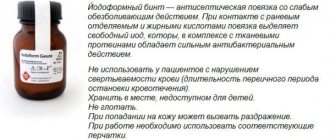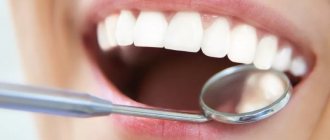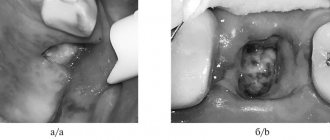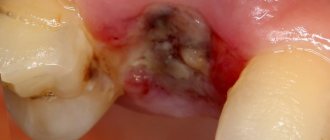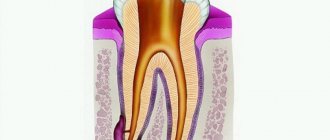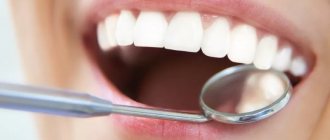Dry tooth socket: features of the disease
A dry socket appears in two cases after tooth extraction. In the first, a blood clot may fall out or dissolve, while in the second, it may not form initially (usually due to severe bleeding). On average, a similar diagnosis is made to two to five percent of people who have undergone a tooth extraction procedure, but dry socket after wisdom tooth removal is much more common. In the absence of timely treatment, the disease can progress to the stage of alveolitis, which in turn threatens the appearance of phlegmon or an abscess. What does a dry socket look like? Visually, a dry tooth socket is easy to identify: in the absence of a blood clot, part of the bone is exposed.
Symptoms of dry socket
- After 2 - 3 days, the gums begin to become inflamed and pain appears.
- As the inflammatory process develops, pain increases and manifests itself not only in the oral cavity, but also in the cervical region, as well as in the ear area.
- The appearance of an unpleasant odor and specific taste in the mouth is another characteristic symptom.
- Partial hearing loss may occur.
Long-term healing and tissue restoration
Before moving on to the question of how much the hole (more precisely, the tissues themselves) hurts after removal, let’s discuss how long it takes for it to heal. If the procedure is successful, bleeding stops after 20-30 minutes. This is followed by the stage of formation of a protective clot, after which all pronounced symptoms begin to rapidly decline. Thus, dental experts identify the following signs of normal healing:
- the appearance of a clot in the first couple of hours after surgery,
- tolerable pain in the area of removal,
- there may be a slight increase in temperature, swelling of the gums,
- discomfort when making swallowing movements,
- formation of a white film.
The photo shows the tooth socket immediately after removal.
These symptoms are considered normal, and their peak intensity occurs approximately 2 days after surgery. Already on the fourth day, all of the above manifestations should begin to subside. If the pain and swelling only intensify, and an unpleasant odor appears in your mouth, you should urgently consult a doctor.
Causes of dry socket after tooth extraction
- Smoking (especially immediately after tooth extraction).
- Poor oral hygiene over a long period of time.
- Poor blood clotting or taking blood thinners.
- Frequent rinsing of the mouth.
- Mechanical impact on the socket and soft tissue in its area.
In addition to the factors mentioned above, much depends on the extraction procedure itself: improperly performed tooth extraction contributes to a number of complications, including dry socket and alveolitis. To prevent this unpleasant phenomenon, dentists recommend limiting physical activity for a few days after tooth extraction, and also not chewing on this side of the jaw (especially hard foods). Under no circumstances should you touch the hole and the area around it with your hands or foreign objects. Bad habits (drinking alcohol and smoking) should be eliminated during healing. The doctor usually prescribes anti-inflammatory drugs for rinsing the mouth (miramistin, chlorhexidine or furatsilin), but this procedure should be carried out no more than 2 - 3 times a day.
How is the removal procedure carried out?
The procedure is always performed under anesthesia, most often local anesthesia. However, if a complex extraction is ahead or the patient has an overwhelming fear of dental treatment, the operation can be performed under general anesthesia or sedation. After the anesthetic begins to take effect, the specialist moves the gum tissue slightly away from the walls of the tooth, and then grabs it using special forceps. If we are talking about the upper jaw, then the doctor presses on the instrument with his entire right hand. When it comes to dealing with the lower tooth, the specialist also works with his right hand, but mainly with his thumb.
This is how a tooth is removed
Read more about how the procedure for removing upper teeth differs from the technique of extracting teeth from the lower jaw in our special article>>>
To extract a tooth from the gum and bone tissue, it is necessary to dislocate it. To do this, the doctor makes rotational and oscillatory movements. Regarding what is placed and what is used to fill the cavity after the hole is emptied, no specific manipulations are required here. The doctor only applies a sterile cotton swab to the wound, which must be held in the mouth until the bleeding stops completely. If a complex removal, for example, of a wisdom tooth, has been carried out, it will take more time for the tissue to heal, because the gum is first cut and then sutured, and this involves even greater trauma to the mucous membrane.
Next, the specialist gives important instructions on how to care for the hole and how to rinse it, tells how long it takes to heal and what to do if the wound does not heal for a long time. You need to listen to the dentist very carefully and then strictly follow his recommendations - this is the only way to protect yourself from the development of complications.
Treatment methods for dry tooth socket
If you discover symptoms of a dry socket, immediately contact your dentist: in this case, you should not self-medicate, although on the Internet you can find a lot of advice on how to treat a dry socket at home. Can a dry socket heal on its own? Without therapeutic and preventive measures, the healing process is not always successful and takes longer. What kind of dry socket treatment will be carried out after tooth extraction depends on the degree of development of the inflammatory process.
| Degree of complication | Treatment method |
| Lightweight | Antiseptic and anti-inflammatory drugs available without a prescription. |
| Average | Antibacterial therapy, cleaning the hole and filling it with anti-inflammatory gel. |
| Heavy | In severe stages of the disease (cellulitis, abscess), the patient is sometimes hospitalized, and a number of measures are taken for his rehabilitation, including physical therapy and ultraviolet irradiation. |
Treatment of a dry socket after the removal of a wisdom tooth is carried out in the same way as in the case of other teeth, however, access to the area of inflammation can be complicated due to the distance of the “eight” location.
Treatment of alveolitis -
If alveolitis develops in the socket after tooth extraction, treatment at the first stage should be carried out only by a dental surgeon.
This is due to the fact that the hole may be filled with necrotic decay of a blood clot; there may be inactive fragments and fragments of bone or tooth. Therefore, the doctor’s main task at this stage is to scrape it all out of the hole. It is clear that no patient will be able to do this on their own. Antiseptic rinses and antibiotics (without cleaning the socket) can only temporarily reduce the symptoms of inflammation, but do not lead to healing of the socket. But at a later stage, when the inflammation in the socket subsides, patients will be able to independently treat the socket with special epithelializing agents to speed up its healing.
Thus, the main method of treatment will be curettage of the hole, but there is also a second method - by creating a secondary blood clot in the hole of the extracted tooth. Read more about these methods...
Curettage of the tooth socket for alveolitis -
- Under anesthesia, a festering blood clot, food debris, and necrotic plaque from the walls of the socket are removed. Without removing the necrotic plaque and the disintegration of the blood clot (containing a huge amount of infection), any treatment will be useless.
- The hole is washed with antiseptics, dried, after which it is filled with an antiseptic (iodoform turunda). Usually, the turunda needs to be changed every 4-5 days, i.e. you will have to go to the doctor at least 3 times.
- The doctor will prescribe you antibiotics, antiseptic baths, and painkillers, if necessary.
Doctor's prescriptions after tooth socket curettage –
- NSAID-based analgesics (for pain),
- 0.12-0.2% Chlorhexidine solution for antiseptic rinses (2-3 times a day for 1 minute),
- Antibiotics: usually either Amoxiclav 625 mg tablets (2 times a day for 5-7 days) or Unidox-solutab 100 mg (2 times a day for 5-7 days) are prescribed. These antibiotics are better, but not cheap. Inexpensive ones are Lincomycin capsules 0.25 (2 capsules 3 times a day), but keep in mind that after this antibiotic, problems with the stomach and intestines develop more often.
Method for creating a secondary blood clot -
However, there are 2 situations in which a different treatment method can be used.
This method involves the creation of a secondary blood clot in the socket and, accordingly, if successful, the socket will heal much faster than after constantly placing iodoform turundas into it for 2-3 weeks. It is preferable to use this method only in the following two situations... Firstly, when you consulted a doctor immediately after, for example, you rinsed a clot out of the hole or it fell out on its own (i.e. when the hole is not yet filled with infection and food debris , and there is no necrotic clot disintegration or suppuration). Secondly, when the patient has a sluggish alveolitis for a long period of time, and the socket is filled with inflammatory granulations.
How this technique is carried out - if the hole is empty, then under anesthesia the bone walls of the hole are scraped out with a curettage spoon to create bleeding and the hole fills with blood (video 3). If the hole is filled with granulations, then they are carefully scraped out, i.e. do the same curettage (video 4). Then, in both cases, after the hole is filled with blood, an anti-inflammatory medicine (Alvogel) is placed deep into the hole, and several sutures are placed on the mucous membrane to bring the edges of the wound closer together. Antibiotics are immediately prescribed.
Curettage to create a secondary blood clot: video 3-4
Summary: i.e. In both the first and second methods, curettage of the hole is carried out in the same way, but in the first case, the hole heals slowly under iodoform turundas, and in the second case, a blood clot forms in the hole for the second time, and the hole heals, as it should do under normal conditions .
How long does it take for a dry socket to heal?
Many people are interested in the question of how long it takes for a dry socket to heal. In the absence of complications, the wound heals in 5 - 7 days, and within a month the hole is filled with epithelial tissue. If you have dry socket, the healing process may take longer than two weeks (with proper treatment, of course). As already mentioned, extensive inflammation may occur and even require surgical hospitalization of the patient: in this case, the healing of the dry socket may be very delayed.
Stages of socket healing by day
- The bleeding that occurs after tooth extraction stops after a few minutes , and a blood clot is formed that protects the wound from the penetration of microbes. Under the clot, damaged tissue is being restored, so it is so important to maintain its integrity until the hole heals completely.
- Day 1 – the processes of epithelization (healing) of the wound surface begin.
- Day 3 - signs of epithelization become noticeable, healing begins from the edges of the wound and moves towards the center.
- Day 4 - granulation tissue begins to form - a type of connective tissue that is formed in the body only during wound healing by secondary intention, when there is a strong defect in the skin.
- Day 7 - granulation tissue replaces part of the blood clot, it remains only in the center of the hole. Osteoid (bone) beams begin to appear, indicating bone formation. At the same time, epithelial tissue grows significantly from the edges of the gums.
- 14th -18th day - epithelization of the wound is completely completed, its surface is tightened and heals completely. By this time, the hole is completely filled with granulation tissue, and osteoid tissue is actively developing.
- After a month, a significant part of the hole is filled with new bone tissue. By the end of the second, sometimes third month, this process is completely completed.
- 4th month - bone beams in the newly formed osteoid tissue calcify, it matures: it becomes spongy and does not differ from the rest of the bone. At the same time, the edges of the socket dissolve, the alveolar edge in the area of the extracted tooth becomes thinner and lower than it was before surgery.
General overview
From a technical point of view, socket curettage is a procedure for mechanical cleaning of the inner surface of the alveolar bed. The use of special instruments allows you to prevent the development of a pathological condition, remove foreign objects and deep deposits characteristic of periodontitis. During the planned removal of elements of the dentition characterized by the presence of cystic formations, as well as with diagnosed periodontitis, the procedure is included in the general protocol and is carried out immediately after extraction, eliminating the possibility of side effects.
Natural processes
Even if the tooth extraction was “simple”, pain in the socket at the site of the extracted tooth is a natural consequence that will bother you for 3-4 days.
This is normal and nothing to worry about, but if the pain causes you severe discomfort, consult your doctor and he will recommend that you take painkillers.
Sometimes regular cold compresses applied to the cheek in the area of the extracted tooth will help relieve pain. This could be a cloth soaked in cold water or ice from the freezer wrapped in a cloth.
Tooth socket
In the case of “complex removal”, in which the gums were cut and sutured, special tools were used to gouge out the root, the pain after the procedure will be felt much longer (the doctor will definitely warn you about this), but will still gradually go away on its own.
If the pain does not go away for more than ten days, consult your doctor: there may be complications in the tooth extraction and you will need dental intervention to eliminate them.
Socket bleeding
Socket bleeding most often appears immediately after surgery, although sometimes several days pass between tooth extraction and the onset of bleeding.
Bleeding from the socket of an extracted tooth can occur for several reasons:
- The patient actively disturbs the socket of the extracted tooth - he feels it with his tongue or hands, inaccurately brushes his teeth or aggressively treats the sore spot with an irrigator;
- Physical damage in the socket area - gum injury, fracture of the alveoli, and so on;
- Concomitant diseases of the patient: hypertension, leukemia, etc.
Treatment for alveolar bleeding depends on the cause and source of bleeding.
Healing of the hole
If the gums bleed in the area of the socket, then the problem may be complications after surgery, and the wound will need to be stitched.
If blood comes from the vessels directly in the walls of the socket of the extracted tooth, then it is first cooled, after which the vessels are compressed and a tampon with a hemostatic agent is placed in the socket for 4-5 days.
If local remedies do not give the desired effect, the dentist prescribes the patient to take general hemostatic agents.
Diagnostics
Such a diagnosis is made only by a doctor when he examines the oral cavity. You can't diagnose yourself. After all, alveolitis of the socket is a serious disease.
If it is not treated promptly, serious complications are possible, including blood poisoning. If there is no blood clot at the place where the tooth was pulled out, then this indicates alveolitis.
Norm and pathology
The tooth extraction procedure involves violating the integrity of the soft tissues and mucous membranes, muscles and ligaments that surround the diseased tooth and are responsible for reliably holding the root in the gum. That is why it is quite logical that after the operation a slight inflammation may begin, characteristic of the wound healing period.
Its main symptoms are: moderate pain when speaking and opening the mouth, discomfort when trying to chew even soft food, discomfort at rest and during movement. Bleeding may also occur, which usually stops several hours after the tooth extraction procedure.
At the site of the gum incision, sharp pain may appear, which radiates to the head and can cause the onset of a migraine. Also considered normal is slight swelling, redness or slight bluish discoloration of the soft tissue. Sometimes a person experiences an increase in body temperature, and the injured area may “burn.” These symptoms usually go away on their own a few days after the intervention.
Stages of the procedure
During curettage, purulent and serous contents, dental fragments, and necrotic masses are removed.
Cleaning is carried out in stages:
- anesthesia;
- washing out blood clots and purulent masses with an antiseptic solution;
- cleaning the hole with a curettage spoon from tooth fragments and damaged tissues;
- repeated antisepsis;
- application of medication, bandage.
If infection is present, additional antibacterial drugs are prescribed. After 1 or 2 days, the injured tissues begin to recover, redness and swelling subside.
Other possible complications
We have already said above that one of the most unpleasant and dangerous complications is alveolitis. In a short period of time, this phenomenon can lead to the development of a very dangerous disease - osteomyelitis. Here we are talking about inflammation of bone tissue. The disease is serious and requires complex and lengthy treatment. Experts include the following complications as other potential problems:
- inflammation of the soft tissues of the gums - occurs after a traumatic procedure or loss of a blood clot. In the wound, pus begins to secrete, fibrous and granulation tissue begins to form. The mucous membrane swells noticeably, the wound begins to bleed, and the patient experiences throbbing pain. The cause of the problem is often an incompletely removed cystic formation,
- flux - if a tooth had to be removed due to severe damage as a result of suppuration of the periosteum or the formation of a purulent cavity in the thickness of the gums, then there is a certain risk of re-inflammation. This can happen if insufficient quality antiseptic treatment was carried out,
- dry socket - loss of protective barter in the form of a blood clot leads to drying out of the wound. Pain appears, the surrounding tissues turn red, and bad breath occurs. Poor hygiene, smoking, too frequent and intense mouth rinsing, as well as accidental mechanical damage to the clot can be a provoking factor.
- paresthesia - appears due to irritation of nerve endings during the procedure. The patient may experience numbness in the tongue, lips, chin and cheeks. This phenomenon is usually temporary and goes away on its own after 5-10 minutes.
The patient may experience numbness in the tongue, lips, chin and cheeks.
To avoid such problems, sometimes doctors perform gum curettage after tooth extraction. A similar procedure is often prescribed as part of the treatment of the complications described above. Essentially, this is the cleansing of gum pockets from plaque and deposits. But in this case, the doctor removes abscess lesions, fragments of crowns and fillings, as well as other foreign particles that can cause inflammation.
Read more about potential complications after tooth extraction in our special material >>>
Blackening of the gums
A change in gum color does not always indicate the onset of inflammatory processes. If the gums at the site of the incision become whitish, this is considered one of the normal variants. This is how fibrin manifests itself, which tightens the wound and protects it from bacteria getting inside.
However, if the bed and adjacent fabrics have turned dark blue or black, this is a cause for concern. Blueness indicates the transition of inflammation to the third stage, which can lead to complete atrophy of the gum tissue.
The gums begin to turn black already when the irreversible process of decay has begun. This is usually accompanied by purulent discharge, a strong and very unpleasant odor from the mouth, and severe pain that cannot be controlled with conventional painkillers.



